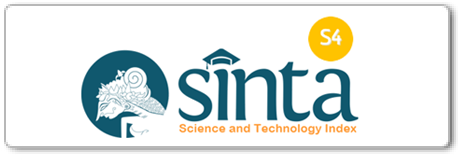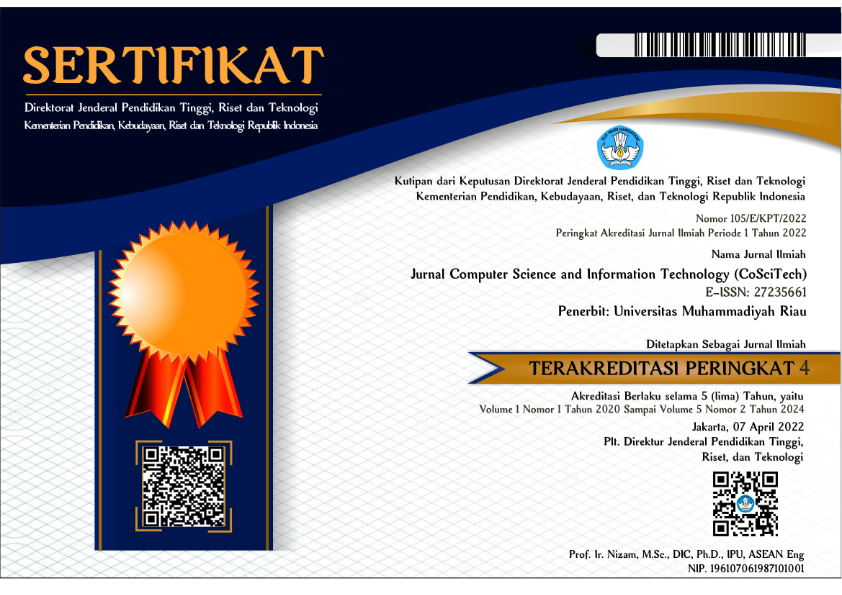Pengelompokan pembagian zakat dengan menggunakan metode clustering k-means
DOI:
 https://doi.org/10.37859/coscitech.v4i1.4804
https://doi.org/10.37859/coscitech.v4i1.4804
Abstract
Zakat is a worship that involves property. Zakat is also included in the fourth pillar of Islam which has the aim of purifying the assets of every Muslim by setting aside a portion of his wealth, if it has reached the time and the amount is given to those who are entitled to receive it. The collection and distribution of zakat is usually handled by the Amil Zakat Agency (BAZ) in every region of Indonesia, one of which is in Pekanbaru. In accordance with the regulations, there are two stages in providing assistance to mustahik, namely conducting interviews and field observations, then determining the nominal amount of assistance given to the Mustahik category of recipients of zakat 1, zakat 2, and zakat 3. Problems that are often encountered in determining potential recipients assistance is a way of selecting Mustahik which still uses the manual method, so that it often causes problems such as the length of the selection process and the occurrence of miscalculations so that the results of Mustahik's selection become inaccurate. For that, it is necessary to create analysis that can process data into information. Data mining is a process for processing data into information using statistical techniques, AI, and machine learning. There are many methods in data mining. In this study using the k-means clustering and for testinguse Davies Bouldin Index. based on testing using the davies bouldin index (DBI) cluster 4 is the best cluster with a value of 0.671, where the lower the value, the better the cluster.
Downloads
References
[2] E. Haerani and R. Ramdaril, “Sistem Pendukung Keputusan Pendistribusian Zakat Pada Baznas Kota Pekanbaru Menggunakan Fuzzy Multiple Attribute Decission Making (FMADM) Dan Simple Additive Weighting (SAW),” J. Tek. Inform., vol. 10, no. 2, pp. 159–168, 2018, doi: 10.15408/jti.v10i2.6994.
[3] Akbarizan, R. Kurniawan, M. Z. A. Nazri, S. N. H. S. Abdullah, S. Murhayati, and Nurcahaya, “Using Bayesian network for determining the recipient of Zakat in BAZNAS Pekanbaru,” Proc. - 2018 2nd Int. Conf. Electr. Eng. Informatics Towar. Most Effic. W. Mak. Deal. with Futur. Electr. Power Syst. Big Data Anal. ICon EEI 2018, no. October, pp. 12–17, 2018, doi: 10.1109/ICon-EEI.2018.8784142.
[4] K. Fatmawati and A. P. Windarto, “Data Mining: Penerapan Rapidminer Dengan K-Means Cluster Pada Daerah Terjangkit Demam Berdarah Dengue (Dbd) Berdasarkan Provinsi,” Comput. Eng. Sci. Syst. J., vol. 3, no. 2, p. 173, 2018, doi: 10.24114/cess.v3i2.9661.
[5] H. Annur, “Penerapan Data Mining Menentukan Strategi Penjualan Variasi Mobil Menggunakan Metode K-Means Clustering ( Studi Kasus Toko Luxor Variasi Gorontalo ),” vol. 5, no. 1, 2019.
[6] M. L. Sibuea and A. Safta, “Pemetaan Siswa Berprestasi Menggunakan Metode K-Means Clustring,” Jurteksi, vol. 4, no. 1, pp. 85–92, 2017, doi: 10.33330/jurteksi.v4i1.28.
[7] H. Sulastri and A. I. Gufroni, “Penerapan Data Mining Dalam Pengelompokan Penderita Thalassaemia,” J. Nas. Teknol. dan Sist. Inf., vol. 3, no. 2, pp. 299–305, 2017, doi: 10.25077/teknosi.v3i2.2017.299-305.
[8] R. Kurniawan, P. Pizaini, and F. Insani, “Penerapan Algoritma K-Means Clustering dan Correlation Matrix Untuk Menganalisis Risiko Penyebaran Demam Berdarah di Kota Pekanbaru,” JIMP (Jurnal Inform. …, vol. 6, no. 3, pp. 1–6, 2021, [Online]. Available: http://ejurnal.unmerpas.ac.id/index.php/informatika/article/view/353.
[9] R. Anggraini, E. Haerani, and I. Afrianty, “Pengelompokkan Penyakit Pasien Menggunakan Algoritma K-Means,” vol. 9, no. 6, pp. 1840–1849, 2022, doi: 10.30865/jurikom.v9i6.5145.
[10] M. F. Julianto, S. W. Hadi, S. Setiaji, W. Gata, and R. Pebrianto, “Clustering Pencapaian Target Penjualan Rumah Para Karyawan Marketing Menggunakan Rapid Miner Dan Algoritma K-Means,” Bianglala Inform., vol. 8, no. 2, pp. 79–85, 2020, doi: 10.31294/bi.v8i2.8189.
[11] D. A. Nasution, H. H. Khotimah, and N. Chamidah, “Perbandingan Normalisasi Data untuk Klasifikasi Wine Menggunakan Algoritma K-NN,” Comput. Eng. Sci. Syst. J., vol. 4, no. 1, p. 78, 2019, doi: 10.24114/cess.v4i1.11458.
[12] R. W. Sari, A. Wanto, and A. P. Windarto, “Implementasi Rapidminer Dengan Metode K-Means (Study Kasus: Imunisasi Campak Pada Balita Berdasarkan Provinsi),” KOMIK (Konferensi Nas. Teknol. Inf. dan Komputer), vol. 2, no. 1, pp. 224–230, 2018, doi: 10.30865/komik.v2i1.930.
[13] R. Hablum, A. Khairan, and R. Rosihan, “Clustering Hasil Tangkap Ikan Di Pelabuhan Perikanan Nusantara (Ppn) Ternate Menggunakan Algoritma K-Means,” JIKO (Jurnal Inform. dan Komputer), vol. 2, no. 1, pp. 26–33, 2019, doi: 10.33387/jiko.v2i1.1053.
[14] F. Indriyani and E. Irfiani, “Clustering Data Penjualan pada Toko Perlengkapan Outdoor Menggunakan Metode K-Means,” JUITA J. Inform., vol. 7, no. 2, p. 109, 2019, doi: 10.30595/juita.v7i2.5529.














